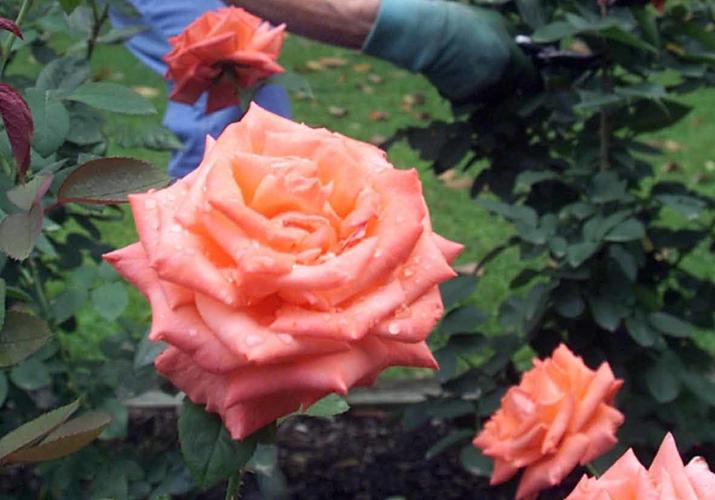People love roses, and roses are among the more commonly planted landscape shrubs. Proper care is important as roses go through the hottest and most stressful time of the year. Even with good care, however, roses typically do not look as good in mid- to late-summer as they did earlier.
Not too much, not too little
The intense heat of summer can dry out beds surprisingly fast. Roses planted in the past six to eight months need a regular, deep watering whenever about a week goes by without adequate rain.
Established roses are remarkably drought tolerant and generally do not require a great deal of supplemental irrigation. I rarely water my established Knock Out and old garden roses.

Controlling fests should be done weekly through the summer.
However, during exceptionally dry periods when rain has not fallen for more than 10 days, you should water roses in the landscape deeply once a week as needed. But don’t overdo it. Problems seen with Knock Out roses are often associated with excessive irrigation.
When watering, avoid wetting the foliage by using drip irrigation, soaker hoses or an irrigation system that sprays water below the foliage. Wetting the foliage encourages fungal leaf diseases like black spot. If you must wet the foliage, irrigate during the morning on a sunny day when the foliage will dry rapidly.

Roses put on a colorful show.
Light on the fertilizer
Due to the intense heat, the flowers that your rose bushes produce in mid- to late-summer are often smaller and the colors more washed out than those produced in the spring. The flowers also will not last as long after they open — fading rapidly in the heat.
Many gardeners interpret the poor-quality flowers to mean that the roses need more fertilizer.
Because heat is the issue, however, fertilizer will not help. Apply fertilizer moderately, if at all, this time of the year. The next best time to fertilize roses will be in late August.

Controlling fests should be done weekly through the summer.
Making some cutbacks
Once-blooming roses can be pruned now, in early summer, after they finish blooming. Many of the climbing roses, the rambler roses and some old European garden roses are once-blooming. These roses bloom heavily in the spring and early summer and then not at all for the rest of the year.
They will bloom next year on growth they make this summer after you prune. Study a climbing rose carefully, decide what you need to prune to train the plant the way you want it to grow, and then prune accordingly. Get this pruning done by the end of June.
Most of the roses in our landscapes by far are repeat-flowering roses that bloom intermittently from late spring to early winter. They should not be pruned hard during the intense heat of summer.

Sweet Drift roses are shown blooming in the fall.
The two major pruning opportunities are late January through early February and late August through early September. Pruning at those times stimulates vigorous new growth and flowers during the outstanding spring/early summer and fall/early winter blooming seasons.
You can manage the size of a rose bush to some degree during the summer when pruning off faded flowers (deadheading). Generally, we deadhead by cutting back to the first five-leaflet leaf below the faded flower or flower cluster. To curb the enthusiasm of more vigorously growing roses, cut back farther to the second or third five-leaflet leaf.
Controlling pests
For roses highly susceptible to black spot (such as many of the hybrid tea and grandiflora cultivars), a weekly spray program is important through the summer months. A fungus causes black spot disease causes leaves to develop black spots, then turn yellow and drop. Susceptible cultivars can be defoliated repeatedly during the summer if the disease is not controlled.
Spraying occasionally will not control this disease. Bushes must be sprayed regularly through the summer. Even with persistent efforts, black spot can show up when we get frequent afternoon rainfall. Still, spraying will help.
Roses that are more resistant to black spot, including landscape roses such as Knock Out roses, Drift roses and others, do not need to be sprayed. These roses will get black spot disease on occasion during rainy weather, but their resilience and stamina allow them to move on and recover without fungicide sprays.
Also, various insects will chew on the foliage or even the flower petals on occasion, but damage is generally minor and spraying insecticides is usually not needed.
Keeping the weeds down
Keep beds well mulched to minimize weeds. Mulches should be about two or three inches thick. You may use any mulch based on cost, availability and personal preference.
A preemergence herbicide labeled for use around roses, such as Preen or Amaze, can also help prevent weeds. After weeding the bed, apply the preemergence herbicide following label directions. These herbicides kill germinating weed seeds and help keep weeds from growing back in the bed. For growing weeds, hand weeding should be done regularly.
This time of the year is not ideal for planting roses as the heat makes establishment less certain. Definitely don’t try to dig up and transplant a rose bush now as it is unlikely to survive. Wait until November or December.
With good care, your roses will come through the heat of summer, as they usually do, and provide abundant flowers in the fall.







